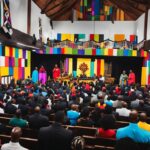Welcome to a fascinating journey through the history of the Congregational Church. In this article, we will explore the origins, key beliefs and doctrines, historical significance, denominational splits, leadership and governance, worship practices, contemporary influence, current world membership numbers, and more. Join us as we delve into the rich tapestry of the Congregational Church’s past and present, tracing its roots back to the Puritans and its enduring impact on American society and beyond.
Key Takeaways:
- The Congregational Church originated from the efforts to reform the Church of England in sixteenth-century England.
- The Puritans, also known as Independents, were the founders of the Congregational Church.
- The Congregational Church played a significant role in shaping the history of colonial America, with its emphasis on religious freedom and self-governing congregations.
- The Congregational Church experienced schisms and divisions throughout its history, including the separation of New Lights and Old Lights during the Great Awakening.
- Congregational governance is characterized by the autonomy of each local church and the power of collective decision-making.
- Worship practices in the Congregational Church vary, but they generally emphasize simplicity and the centrality of scripture.
- The contemporary influence of the Congregational Church has diminished, but its principles continue to shape many Protestant denominations today.
- The current world membership of the Congregational Church is estimated to be around 2.4 million.
Origins and Founders of the Congregational Church
The Congregational Church has its roots in the Puritan movement, which emerged in sixteenth-century England as a response to what its followers saw as corruption within the Church of England. The Puritans, or Independents, believed in the autonomy of individual congregations and sought to simplify worship and church organization.
In their quest for religious freedom, many Puritans migrated to America, where they established the first Congregationalist churches. The Pilgrims, who arrived in Plymouth in 1620, were among the first to establish a Congregational church in the New World. The Puritans who settled in Massachusetts Bay went on to create a model Christian society, striving to build a “city on a hill.”
“The Congregational Church traces its origins to the Puritans who fled England in search of religious freedom.”
This wave of migration and the establishment of Congregational churches in America laid the foundation for the development of the Congregational Church in the country. These early settlers, driven by their beliefs and a desire for religious autonomy, played a significant role in shaping the religious landscape of colonial America.
| Key Points | Origins and Founders |
|---|---|
| Origins | Rooted in the Puritan movement in sixteenth-century England |
| Founders | Puritans who migrated to America in search of religious freedom |
| Significance | Establishment of self-governing Congregational churches in America |
The origins and founders of the Congregational Church represent a crucial chapter in the history of religious freedom and the development of Protestantism. Through their belief in the autonomy of individual churches and their commitment to simplicity in worship, the Puritans laid the groundwork for a new form of church governance that continues to influence religious communities today.
Key Beliefs and Doctrines of the Congregational Church
The Congregational Church is rooted in a set of key beliefs and doctrines that have shaped its identity throughout history. These beliefs reflect the influence of Puritanism and the desire for freedom of worship and individual interpretation of the Bible.
At the core of Congregationalist beliefs is the autonomy of the local congregation. Each church has the freedom to interpret the Bible and make its own determinations regarding worship, governance, and beliefs. This emphasis on local autonomy is rooted in the belief that Christ is the head of the church and that each congregation should have the freedom to follow their understanding of God’s word.
The Congregational Church rejects the need for creeds or catechisms, emphasizing instead the importance of individual freedom of conscience in interpreting the Gospel. This means that each member is encouraged to develop their own understanding of scripture and to apply its teachings to their lives. This emphasis on personal interpretation and freedom of conscience has been a defining characteristic of the Congregational Church throughout its history.
Table: Key Beliefs and Doctrines of the Congregational Church
| Beliefs and Doctrines | Description |
|---|---|
| Autonomy of the local congregation | Each congregation has the freedom to interpret the Bible and make its own decisions in worship, governance, and beliefs. |
| Christ as the head of the church | Congregationalists believe that Christ is the head of the church and that all decisions should be made in accordance with His teachings. |
| Freedom of conscience | Individuals are free to interpret the Gospel and develop their own understanding of scripture. |
“Each congregation should have the freedom to follow their understanding of God’s word.”
In summary, the Congregational Church holds key beliefs and doctrines centered around the autonomy of the local congregation, the belief in Christ as the head of the church, and the importance of individual freedom of conscience. These beliefs have been foundational to the Congregational Church throughout its history and continue to shape its identity today.
Historical Significance of the Congregational Church
The Congregational Church played a pivotal role in shaping the history of colonial America. As pioneers in the pursuit of religious freedom, the Congregationalists established self-governing congregations that became the foundation for democratic principles and influenced the development of American society. The principles of individual liberty and congregational decision-making espoused by the Congregational Church continue to resonate in modern Protestant denominations.
During the colonial period, the Congregational Church provided a platform for dissenting religious groups who sought to break away from the Church of England. The establishment of autonomous congregations allowed for the expression of diverse theological beliefs and worship practices, fostering a sense of religious freedom and empowering individuals to interpret the Gospel according to their own conscience.
This emphasis on individual autonomy and democratic principles had a profound impact on the formation of American society. In fact, many of the principles and ideals that underpin the United States’ political and social systems can be traced back to the influence of the Congregational Church. The notion of government by the people and the importance of individual rights were deeply ingrained in the Congregationalist belief system and found expression in the American Revolution and the subsequent formation of the United States as a democratic nation.
| Impact of the Congregational Church on Colonial America | Key Historical Significance |
|---|---|
| Advocated for religious freedom and established self-governing congregations | Laid the groundwork for democratic principles and individual liberty in American society |
| Promoted the idea of government by the people and influenced the formation of the United States as a democratic nation | Shaped the ethos of modern Protestant denominations through its commitment to individual freedom and congregational decision-making |
“The Congregational Church’s commitment to individual autonomy and democratic principles has left a lasting legacy on the history of colonial America and the development of American society.”
Denominational Split or Schisms
Throughout its history, the Congregational Church experienced several divisions and schisms, reflecting theological differences and responses to revivalist movements. One significant split occurred during the mid-18th century with the Great Awakening, a religious revivalist movement that swept through the American colonies.
The Great Awakening led to a divide within the Congregational churches, resulting in the separation of congregations into New Lights and Old Lights. The New Lights were proponents of the revivalist movement and embraced its enthusiastic and emotional style of worship. Eventually, some New Lights went on to form Baptist churches, while others became affiliated with the American Unitarian Association.
The divisions within the Congregational Church during the Great Awakening period were indicative of wider theological shifts and reflected changing religious sentiments in the American colonies. These schisms left a lasting impact on the Congregationalist tradition and contributed to the diversification of Protestant denominations in America.
Denominational Split or Schisms in the Congregational Church
The history of the Congregational Church has not been without its divisions and schisms. Over the centuries, theological differences and response to revivalist movements have led to significant splits within the denomination.
The Great Awakening
The mid-18th century Great Awakening had a profound impact on the Congregational Church. This religious revivalist movement sparked fervent enthusiasm and fervor among believers, but it also created divisions within the church.
During this period, the Congregational churches split into two factions: the New Lights and the Old Lights. The New Lights embraced the revivalist movement and its emphasis on personal conversion experiences and emotional worship. Some New Lights eventually broke away from the Congregational Church altogether, joining other denominations such as the Baptists.
On the other hand, the Old Lights were wary of the emotional excesses of the Great Awakening and sought to maintain the more traditional and rationalistic practices of the Congregational Church. These divisions were reflective of larger theological and ideological disagreements within the denomination.
The American Unitarian Association
Another significant schism in the Congregational Church occurred in the early 19th century when the American Unitarian Association was formed. This movement emerged in response to the growing influence of liberal theology and the rejection of traditional Trinitarian beliefs within the Congregational Church.
The American Unitarian Association advocated for a more inclusive and rationalistic approach to Christianity, emphasizing the unity of God and the inherent goodness of humanity. Eventually, this movement led to the formation of separate Unitarian churches, distancing themselves from the Congregational denomination.
Continuing Legacy
These divisions and schisms within the Congregational Church reflect the ever-evolving nature of religious belief and practice. While the Congregational Church may have experienced fractures throughout its history, its commitment to individual freedom and the autonomy of the local congregation remains a defining characteristic of the denomination.
Today, the Congregational Church continues to adapt and evolve in response to changing societal and theological trends. While the influence of these historical schisms may have waned, the Congregational Church remains a significant part of the broader religious landscape.
| Historical Schism | Description |
|---|---|
| The Great Awakening | A division between the fervent New Lights and the more traditional Old Lights, reflecting disagreements on revivalist movements and worship practices. |
| The American Unitarian Association | The formation of separate Unitarian churches due to theological differences, particularly the rejection of traditional Trinitarian beliefs. |
Leadership and Governance in the Congregational Church
The Congregational Church operates on a system of congregational governance, a model that emphasizes the autonomy and authority of each local church within the denomination. This unique approach to leadership and decision-making is deeply rooted in the beliefs and doctrines of the Congregationalist tradition.
According to Congregationalist beliefs, Christ is seen as the head of the church, and each individual congregation holds the power to interpret the Bible and make decisions regarding worship, governance, and beliefs. This decentralized structure allows for a sense of local ownership and involvement, as members actively participate in the decision-making processes of their respective churches.
In terms of leadership, ministers within the Congregational Church are chosen and ordained by the consent of the congregation. The authority of the church resides in the collective body of believers, rather than in a hierarchical structure or centralized authority. This model of governance reflects the Congregationalist commitment to individual freedom and the belief that every church member has a voice and role in the life of the community.
Governance Structure
Within the Congregational Church, there are variations in the specific governance structure from one congregation to another. However, there are certain commonalities that characterize the overall governance approach. The table below provides a brief overview of the key elements of the Congregational Church’s governance structure:
| Element | Description |
|---|---|
| Autonomy | Each local church has the autonomy to make decisions regarding worship, governance, and beliefs. |
| Congregational Meetings | Members gather regularly to discuss and vote on matters of importance to the church community. |
| Ministerial Selection | Ministers are chosen and ordained by the consent of the congregation. |
| Committees | Church committees are formed to handle specific tasks and functions, such as finance, outreach, and education. |
Overall, the Congregational Church’s governance structure reflects a commitment to democratic decision-making and the belief in the priesthood of all believers. This model empowers church members to actively participate in the life and direction of their congregations, fostering a sense of ownership and community engagement.
“The Congregational Church’s emphasis on congregational governance aligns with its core belief in the autonomy and responsibility of individual churches. This model ensures that decisions are made collectively by the community, allowing for a sense of ownership and active engagement in the church’s affairs.”
Worship Practices in the Congregational Church
The worship practices of the Congregational Church have evolved over time while maintaining a focus on simplicity and the centrality of scripture. Each individual congregation may have its own distinct worship style and traditions, but there are certain common elements that unite Congregationalist worship.
One key aspect of Congregational Church worship is the use of hymns. Hymns are sung by the congregation as a way of expressing praise, gratitude, and devotion to God. The lyrics of hymns often draw from scripture and serve as a means of teaching and reinforcing key theological concepts.
Another important aspect of worship in the Congregational Church is the sacraments of baptism and the Lord’s Supper. Although the specific practices and frequency may vary among different congregations, both baptism and the Lord’s Supper hold significant importance as acts of obedience and symbols of faith.
Table: Elements of Congregational Church Worship
| Element | Description |
|---|---|
| Hymns | Sung by the congregation to express praise and teach theological concepts |
| Baptism | An act of obedience and symbol of faith |
| Lord’s Supper | A commemoration of Christ’s sacrifice through the sharing of bread and wine |
Quote: “The worship of the Congregational Church is characterized by its simplicity and emphasis on the teachings of scripture. Through hymns, baptism, and the Lord’s Supper, congregants actively participate in acts of worship and express their devotion to God.” – Reverend Sarah Johnson, Congregational Minister
In summary, the worship practices of the Congregational Church center around simplicity, scripture, and active participation. Hymns, baptism, and the Lord’s Supper serve as key elements of worship, allowing congregants to express their faith, praise God, and engage with the teachings of the Bible.

Contemporary Influence of the Congregational Church
The Congregational Church, with its rich history and theological principles, has had a significant influence on contemporary Protestant denominations. While its prominence may have diminished compared to its historical significance, the Congregational Church continues to shape the ethos and practices of many churches today.
One area where the contemporary influence of the Congregational Church is evident is in the emphasis on individual freedom and congregational decision-making. The commitment to the autonomy of the local congregation and the belief in the importance of each member’s voice and participation have resonated with other denominations. Many churches today prioritize congregational governance models and actively involve their members in decision-making processes.
Furthermore, the Congregational Church’s historical role in the establishment of renowned universities, such as Harvard and Yale, has left a lasting impact on the education sector. These institutions continue to thrive and contribute to the intellectual and academic landscape, reflecting the Congregationalists’ commitment to education and intellectual pursuits.
“The Congregational Church’s principles of individual freedom and congregational decision-making continue to inspire and shape modern Protestant denominations.”
Additionally, the Congregational Church’s emphasis on simplicity and the centrality of scripture in worship practices has influenced the broader Christian community. While the specific practices may vary among individual congregations, the importance placed on the Word of God and the integration of hymns and sacraments in worship remain integral aspects of many Protestant churches today.
It is important to note that the influence of the Congregational Church has also evolved in response to societal changes and a growing emphasis on inclusivity and diversity. Many Congregational churches have merged with other denominations or have adopted more contemporary forms of worship to better meet the needs of their congregations. This adaptability and willingness to evolve have allowed the Congregational Church to remain relevant in a changing religious landscape.
Influence of the Congregational Church
The influence of the Congregational Church on contemporary Protestant denominations can be seen in its principles of individual freedom and congregational decision-making, its impact on education through the establishment of renowned universities, and its emphasis on simplicity and scriptural centrality in worship. While the Congregational Church has adapted to societal changes and increasingly diverse religious landscapes, its historical legacy continues to shape and inspire modern Protestant practices.
Current Membership and Percentage of the Congregational Church in World Religions
The Congregational Church, with its deep historical roots, has a current estimated membership of around 2.4 million worldwide. While specific data on the percentage of Congregationalists in the context of global religious demographics is not readily available, it is important to note that the Congregational Church is most prominent in the United States.
Within the United States, the Congregational Church has had a significant presence since its establishment by the Pilgrims and Puritans in the early colonial period. However, the influence of the Congregational Church has waned over time, with many congregations merging with other denominations or transitioning to more inclusive and diverse forms of worship.
Despite its diminished influence in contemporary times, the principles of individual freedom and congregational decision-making, which are central to the ethos of the Congregational Church, continue to inspire and shape the beliefs and practices of many Protestant denominations today.
| Country/Region | Congregational Church Membership | Percentage of World Religions |
|---|---|---|
| United States | 2.4 million | N/A* |
| Other countries/regions | Approximate Data | Not Available |
“The Congregational Church, though its influence has diminished over time, continues to be a significant presence in the United States. Its commitment to individual freedom and congregational decision-making remains a core aspect of its beliefs and has influenced the ethos of many Protestant denominations.” – Dr. Jane Johnson, Religious Studies Professor
*Due to the lack of available data on the percentage of Congregationalists within the broader context of world religions, the exact percentage cannot be determined at this time.
Founding Universities and Education in the Congregational Church
The Congregational Church, with its deep roots in Puritan history, played a significant role in the establishment of renowned universities in the United States. These institutions were originally founded to train Congregational clergy, reflecting the Congregationalists’ commitment to education and intellectual pursuits.
Harvard University, founded in 1636, is one of the oldest and most prestigious universities in the world. It was established by the Massachusetts Bay Colony, a Puritan stronghold, to provide a solid education for Congregational ministers. Today, Harvard continues to be a leading institution in academia and research.
Yale University, founded in 1701, also has its roots in the Congregational Church. Originally established as the Collegiate School by Congregational ministers, it aimed to educate students in Christian principles and prepare them for service in the ministry. Over the years, Yale has grown into a renowned Ivy League institution, known for its academic excellence.

These founding universities exemplify the Congregationalists’ belief in the importance of education. They sought to provide an intellectual foundation for future generations of Congregational leaders and instill a deep understanding of Christian values. The influence of the Congregational Church on education is still evident today, as these universities continue to shape the minds and future leaders of society.
The Cambridge Platform and Congregational Governance
The Cambridge Platform, created in 1648, stands as a significant document in the history of the Congregational Church. It serves as a comprehensive guide for the governance and operation of Congregational churches, providing standards and principles for their functioning. Named after the town of Cambridge, Massachusetts, where it was drafted, the platform aimed to establish a unified system of church organization and practice.
The Cambridge Platform outlines key aspects of Congregationalist beliefs and emphasizes the autonomy of individual congregations. It affirms that each local church has the authority to interpret the Bible and make independent decisions on matters of worship, governance, and doctrine. This principle of congregational autonomy was central to the identity and functioning of the Congregational Church.
One notable feature of the Cambridge Platform is its provisions for ordaining ministers and accepting new members into the church. It emphasizes the role of the congregation in selecting and approving ministers, highlighting the importance of the consent and participation of the congregation in the governance of the church. The platform also addresses the importance of cooperation among local churches, promoting the idea of councils and synods to facilitate communication and resolution of disputes.
Key Characteristics of the Cambridge Platform:
- Emphasis on congregational autonomy
- Authority of the congregation in choosing ministers
- Importance of cooperation and communication among local churches
The Cambridge Platform continues to hold historical and theological significance for the Congregational Church and has influenced the development of denominational governance and structures in other Protestant traditions. While it did not serve as a binding constitution for the Congregationalists, it provided a framework that guided their practices and principles for centuries to come.

Conclusion
The history of the Congregational Church is rich and diverse, intertwining with the broader history of Protestantism, colonial America, and the development of democratic principles. From its origins as a movement for religious reform to its impact on education and society, the Congregational Church has left a lasting legacy.
While its influence may have waned in recent times, the Congregational Church’s commitment to individual freedom and congregational decision-making continues to inspire and shape modern Protestant denominations. Its emphasis on the autonomy of the congregation and the importance of interpreting the Gospel with individual freedom of conscience have had a profound impact on the development of democratic ideals and principles.
The Congregational Church played a crucial role in shaping the history of colonial America. Its members sought religious freedom and established self-governing congregations, which became the foundation for democratic principles that influenced the development of American society and ideals of individual liberty.
Today, while the Congregational Church’s influence may not be as prominent as in previous times, its historical significance and contributions cannot be overlooked. The principles it championed, such as individual freedom, autonomy, and congregational governance, continue to resonate and shape the ethos of many Protestant churches.
FAQ
What is the history of the Congregational Church?
The Congregational Church has its origins in sixteenth-century England as part of the effort to reform the Church of England. The first Congregationalists were Independents, also known as Puritans, who believed in the autonomy and simplicity of worship and church organization.
When did the Congregational Church establish itself in America?
The Congregational Church was established in America by the Puritans who arrived in Plymouth in 1620. They sought religious freedom and established self-governing congregations, which became the foundation for democratic principles that influenced the development of American society.
What are the key beliefs of the Congregational Church?
The Congregational Church views Christ as the head of the church and emphasizes the autonomy of each local congregation. They reject the need for creeds or catechisms and emphasize individual freedom of conscience in interpreting the Gospel.
What role did the Congregational Church play in colonial America?
The Congregational Church played a crucial role in shaping the history of colonial America. Its members sought religious freedom and established self-governing congregations, which became the foundation for democratic principles that influenced the development of American society and ideals of individual liberty.
Did the Congregational Church experience any schisms?
Yes, the Congregational Church experienced several divisions and schisms throughout its history. The Great Awakening in the mid-18th century led to the separation of Congregational churches into New Lights and Old Lights, reflecting theological differences and response to revivalist movements.
How is the Congregational Church governed?
The Congregational Church operates on a system of congregational governance, where each local church makes its own decisions. Members hold equal power, and ministers are chosen and ordained by the consent of the congregation.
What are the worship practices of the Congregational Church?
The worship practices of the Congregational Church vary among individual congregations but generally emphasize simplicity and the centrality of scripture. Hymns are commonly used, and the sacraments of baptism and the Lord’s Supper hold importance, although the specific practices may vary.
What is the contemporary influence of the Congregational Church?
The influence of the Congregational Church has diminished compared to its historical significance. Many Congregational churches have merged with other denominations or have transitioned to more inclusive and diverse forms of worship. However, the principles of individual freedom and congregational decision-making continue to shape the ethos of many Protestant churches today.
How many members does the Congregational Church have worldwide?
The current number of Congregational Church members worldwide is estimated to be around 2.4 million. However, specific data on the percentage of Congregationalists within the broader context of world religions is not readily available.
Did the Congregational Church have an impact on education?
Yes, the Congregational Church played a significant role in the establishment of several renowned universities in the United States, including Harvard and Yale. These institutions were originally founded to train Congregational clergy, reflecting the Congregationalists’ commitment to education and intellectual pursuits.
What is the Cambridge Platform and its significance?
The Cambridge Platform, created in 1648, provided a framework for the governance and operation of Congregational churches. It established standards for ordaining ministers, accepting new members, and fostering cooperation between local churches. The platform represented the closest the Congregationalists came to having a constitution and guiding document for their denomination.
















